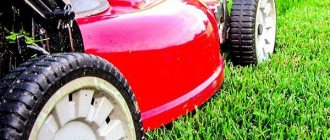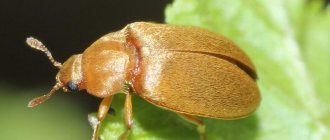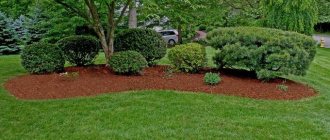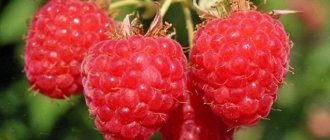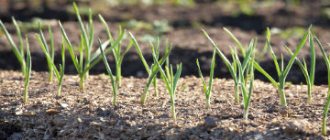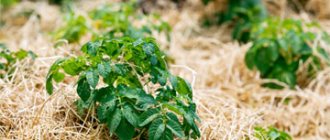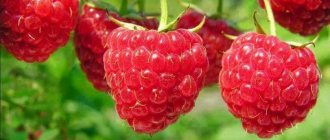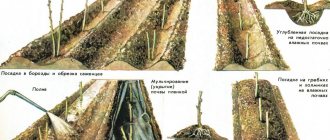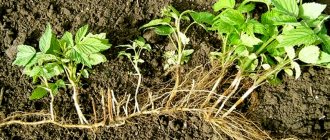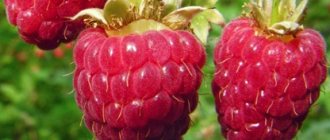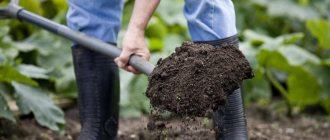What is mulching?
This procedure consists of covering the surface of the raspberry tree soil with various covering materials. Proper mulching:
- creates a favorable thermal regime of the soil, protects roots from overheating and freezing;
- maintains optimal moisture levels in the soil;
- improves the structure of the soil and increases its breathability;
- acts as a source of additional nutrition for raspberries;
- creates a mechanical barrier to light, delaying the germination of weeds;
- prevents the appearance of unwanted young shoots and thickening of raspberries;
- protects the bush from diseases and pests.
When is the best time to perform the procedure?
It is advisable to mulch raspberries twice a year, in spring and autumn. As a rule, the procedure is carried out:
- For the first time - after planting raspberry seedlings.
- After the end of spring frosts and warming of the soil. You also need to wait until the soil dries well.
- Before the onset of the first cold weather in autumn.
Spring mulching
The procedure is carried out in the spring for:
- improving the composition and structure of the soil;
- protecting raspberries from weeds;
- reducing water consumption during irrigation;
- increasing productivity, accelerating raspberry ripening.
Important! Mineral fertilizers should be applied before the covering procedure. If you apply mulch before fertilizing, it will prevent nutrients from penetrating to the roots of the shrubs.
Autumn mulching
Mulching raspberries in the fall allows you to:
- regulate the soil temperature (under a layer of mulch it heats up slowly and cools down for a long time, which has a beneficial effect on the development of roots);
- protect the root system from frost and temperature changes at the end of autumn, when there is still no snow cover;
- prevent the proliferation of pests and the occurrence of diseases.
Attention! In the fall, before mulching, it is necessary to generously water the raspberries, 40-50 liters per sq.m. This procedure saturates the soil with moisture and it freezes much slower than dry soil.
Why and when to mulch strawberries
Mulching as an agricultural technique has been known since the 17th century. The name comes from the English word “molsh”, which means “shelter”. Organic mulch helps improve the structure of the soil, making it looser and more fertile. And, as a result, crop yields increase under such a layer.
In addition, mulching protects the soil from overheating and drying out and prevents the growth of weeds. Due to this, the number of weeding, watering and loosening of the soil is reduced, and the immunity of garden strawberries is improved, and the berry remains clean even after heavy rains.
Experienced gardeners mulch strawberries twice a year. For the first time, strawberries are covered with a layer of mulch in the spring, when ovaries appear on the bushes. As a result, the flower stalks do not come into contact with the soil. After harvesting the last harvest of garden strawberries or at the end of summer, the mulch is removed, and at the end of October the bushes are mulched again to protect the plants from freezing. In the spring, when the strawberries begin to grow, the mulch layer is removed.
But it should be noted that not all materials are suitable for mulching a berry garden in the autumn-winter period. It is best to cover strawberries for the winter with dry leaves, mown grass, straw or pine needles. In this case, the mulch should be spread in a thick layer not on the bushes themselves, but mainly on the soil around and between them. Then mulching strawberries will be as effective as possible.
Regardless of the timing of laying the mulching material (autumn or spring), the soil and plants need to be prepared for this. Strawberries need to remove dry leaves and excess tendrils. You should also weed the weeds, loosen the soil and water it abundantly, apply seasonal fertilizing and only then lay mulch.
Read our review about which material is better to choose.
Materials for mulching raspberries
Organic materials are preferable as mulch for raspberries. The annual use of which ensures the gradual formation of a fertile layer with a high humus content.
For this use:
- Sawdust, straw and grass clippings. They mulch raspberries in the spring.
- Pine bark and compost. They are more suitable for autumn mulching.
- Pine needles and peat are suitable for use in both spring and autumn.
Fresh sawdust
The material is optimal for spring mulching. It is not recommended to use in autumn. During thaws, they absorb large amounts of water and then freeze, creating a strong monolithic shell of ice and sawdust. This leads to late soil warming and stunted plant growth.
The use of sawdust prevents the appearance of weeds and ensures good soil moisture under the bushes. Although the material also has certain disadvantages:
- Soil acidification. It is recommended to monitor the acidity of the soil and, if necessary, carry out procedures to deoxidize it.
- Removal of nitrogen from the soil. The solution would be to increase the amount of fertilizers saturated with this substance during spring feeding.
- Sawdust can attract ants to the raspberry tree.
Important! When watering raspberries, the layer of sawdust mulch must be loosened, otherwise it will not allow moisture to reach the roots.
pine bark
This is the material closest to wild nature. In forest raspberry fields, the role of mulch is played by cones and twigs.
Pine bark:
- allows air and moisture to pass through well, preventing the soil from drying out;
- reduces the number of weeds;
- It overheats for a long time and gradually decomposes, nourishing the soil.
Straw
This is not the best material for mulching raspberries. Straw quickly cakes and causes oxygen deficiency in the root zone of plants. Therefore, it is necessary to loosen it from time to time and add fresh portions.
Advantages of straw:
- availability;
- improvement of the soil during overheating, enriching it with phosphorus and nitrogen;
- protection of plants from gray rot.
Peculiarity! Mulching with straw is advisable in open sunny areas. In shaded lowlands, its wet layer will quickly become a breeding ground for fungi and pests.
Spruce and pine needles
It is recommended to use pine needles for mulching in their rotted form. They will provide:
- reliable protection of plants from overheating and freezing;
- preventing overdrying of roots;
- destruction of pathogenic organisms in the soil;
- ridding raspberries of slugs.
Needles can acidify the soil, so acidity must be controlled. When it increases, it is better to choose another material for mulching.
Cut grass
Before use, the mown grass is dried a little to prevent it from rotting. This material:
- available;
- retains moisture well;
- rotting, it becomes fertilizer;
- protects the root system from the first frosts.
Grass is rarely used as mulch. It dissipates quickly and may contain weed seeds. It also does not provide reliable protection from droughts or frosts.
Peat
It is better to mulch raspberries with high-moor, looser peat rather than low-lying peat. It can be used either in its pure form or in combination with compost or straw.
Peat has many benefits:
- improves the structure of the soil, saturating it with useful substances;
- retains moisture well;
- protects roots from pathogenic microorganisms;
- You can mulch with peat directly over the layer of first snow.
Compost
Such mulch is not the most desirable option for raspberries. If the winter is warm, the consistency of the compost will cause the lower branches to rot. This option is also dangerous due to the high nitrogen content, which stimulates stem growth in winter. Therefore, compost is rarely used. Only if there are no other options, and cover it with a small layer.
However, compost mulch also has its advantages:
- protects the root system well from frost;
- supplies the soil with organic matter;
- It does not compress during the winter and begins to work as a fertilizer already with the first thaw.
Features of mulching in spring and autumn
The table shows the features of raspberry mulching depending on the season:
| Criterion | in spring | in autumn |
| Features of mulching | Mulch after frost, when the soil warms up. If soil moisture is high, mulching is postponed until mid-May. Do not mulch before applying fertilizer. | Mulch after loosening and moistening the soil. Use organic matter with a neutral reaction. Inorganic materials are also used for winter shelter. |
| Choosing Mulch | Manure, hay, newspapers, sawdust, peat, lutrasil and spandbond. Leaf litter, weeds, wood chips and bark are not used as covering material. | Straw, compost, peat, sawdust, leaf litter, spandbond, polyethylene film, agrofibre |
| Mulching result | Improves soil composition, accelerates berry ripening and increases yield | Prevents the development of diseases and the proliferation of pests, protects against frost, mulch nourishes and improves the soil structure |
Timely spring mulching protects against weeds and growths.
Covering material is attached to the soil using steel anchors
How to properly mulch?
Before starting the procedure, it is necessary to remove weeds from the site, moisten and loosen the soil, and apply fertilizing. The process of laying mulch depends on the material chosen:
- Sawdust is poured in piles 10-12 cm high directly at the base of each bush, without covering the entire territory of the raspberry tree.
- Pine bark is covered with a layer 5-7 cm thick. Clay soil is covered with a layer of 3 cm, and loose sandy soil with a layer of 7 cm. The entire area of the berry garden is covered with bark.
- The entire area is not covered with straw; it is laid around each bush with a thickness of 10 cm.
- The entire area of the raspberry tree is covered with pine needles. The layer of needles should be at least 10 cm.
- The cut grass is laid around the bushes in a layer of 4-8 cm.
- The entire area is covered with a uniform layer of peat, maintaining a thickness of 5-7 cm.
- The compost layer should not exceed 5 cm. Fill the entire area of the raspberry tree.
Interesting! Maximum efficiency can be achieved by combining mulch from several materials, laying them on top of each other. Thus, light and dry materials will provide aeration and prevent compaction of the layer, while heavy ones will serve as protection against weeds and weather conditions.
Sheltering plants for the winter
Pine and spruce branches are suitable for winter shelter for grapes, climbing roses, rhododendrons, azaleas, hydrangeas and clematis. They protect plants well from freezing and heating.
First, the lashes are removed from the supports, tied and laid on coniferous branches in a ring or simply bent to the ground and pinned. Instead of branches, you can use the needles themselves. To do this, you need to fill it with a mound, and lay lashes of plants on top. You can combine such a cover with peat or compost, and then also wrap the branches with non-woven covering material.
In a similar way, you can cover winter plantings of vegetables and bulbous plants. The needles are also suitable for insulating the root system of young seedlings. To do this, bags filled with pine needles are placed in the tree trunk circle. Such a shelter will not only protect the roots from severe frosts, but will also ward off uninvited guests - mice and hares.
Gardener mistakes
By incorrectly selecting or laying the mulch, you can cause significant harm to the raspberry tree. The most common mistakes gardeners make when mulching raspberries:
- Incorrect filling of the mulch layer.
- Laying on unheated soil. Then the mulch will absorb the sun's rays and prevent the soil from warming up properly.
- Spread mulch in a thick layer in rainy weather. Waterlogged material will become a favorable environment for the development of putrefactive bacteria.
How can you not pour mulch?
When laying a mulch layer, inexperienced gardeners can make the following mistakes:
- Place mulching material close to the raspberry shoots. It is important to retreat 5-10 cm from the base of each bush. This is necessary to prevent damping off and rotting of the root zone of the plants.
- Sprinkle some mulch between the bushes. In this case, the plants will not receive proper protection. Mulch should be poured in a circle with a diameter of 65-75 cm, and in a layer, the thickness of which depends on the selected material.
- You cannot cover only the emerging shoots with mulch, as the protective layer will inhibit their growth.
Which mulch is not suitable?
There are mulching materials that are completely undesirable to use in raspberry fields:
- Manure. Its dense, heavy consistency will not allow the soil to warm up in the spring. This means that the growing season phases will shift and the crop will not have time to ripen before the cold weather. Manure applied in the fall can be compressed during the winter, which will slow down the germination of young shoots in the spring. In addition, when fresh it can burn plant roots.
- Fallen leaves are unreliable protection for raspberries from frost. But they may contain spores and larvae of pests, the presence of which will subsequently have a detrimental effect on the raspberry tree.
- Hay. Not suitable due to high content of mature weed seeds.
How to mulch raspberries
Every gardener who is wondering what is the best way to mulch raspberries should proceed from what material is available to him in sufficient quantities at the time of the procedure.
It is important to know! The main condition for high-quality mulching is to uniformly cover the area with a sufficient layer. If you add a layer of mulch without observing the thickness of the layer, the effect of the procedure may be zero.
The best materials are recognized as:
To achieve maximum efficiency, the mulch layer can be combined from several materials. Drier materials will promote air exchange, while heavier ones will protect from weather conditions and weeds.
Is it possible to sprinkle sawdust under raspberries? Among summer residents, sawdust is the most popular material. However, experts agree that this is not the best choice, since they cake, and after the spring melting of the snow they completely turn into a crust that cannot be loosened. Also, sawdust does not prevent the growth of weeds. Negative consequences of using sawdust include soil acidification and nitrogen leaching. Therefore, when deciding whether or not to add sawdust to raspberries, it is best to be guided by the principle of having a sufficient amount of other materials. If you only have sawdust on hand, it is better to use them for spring mulching. To increase the nitrogen content, you can add additional fertilizing with nitrogen fertilizers. It is also better to use composted sawdust if possible.
In autumn, raspberries need to be prepared for upcoming frosts and possible temperature changes due to the lack of snow cover. Organic matter is best suited for these purposes: peat, straw, compost, humus or foliage.
How to mulch raspberries in spring:
- Manure is required, since after winter the soil is depleted;
- Straw, hay, wood chips or branches.
Description of basic materials
Manure is popular as mulch, but its advantage is that it also acts as a fertilizer. Since this product is very heavy, it is not worth applying it in early spring - manure mulch will prevent the soil from warming up. The optimal time for mulching with manure is May, when shoots from dormant buds have grown by 30 cm. The layer should be no more than 10 cm; an excess of manure makes the root system lazy, as it constantly receives a large dose of fertilizer. Because of this, the roots can dry out in the summer and freeze in the winter.
Compost is a more suitable material for spring and autumn mulching. It is lighter than manure, does not compact and does not form a crust after winter, so it is perfect as a base layer. Compost is rich in nitrogen, so do not make a layer too thick, 5 cm will be enough. Compost mulching is carried out after mineral fertilizing.
